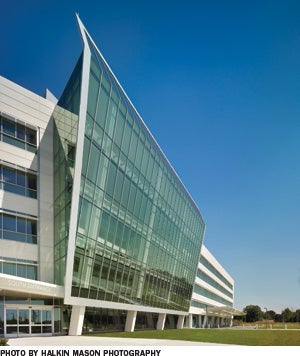New version of LEED pushes building performance

The need to elevate and monitor overall building performance, especially water and energy usage, are major priorities with Leadership in Energy & Environmental Design version 4 (LEED v4), which was launched by the U.S. Green Building Council (USGBC) at its annual conference and expo last month as the latest installment of the building certification program.
"LEED v4 is poised to raise the bar on performance and has the potential to reduce CO2 emissions more than any other versions of the LEED rating systems," USGBC officials say.
Among key objectives, LEED v4:
- Places a renewed importance on integrative processes and the benefits of early design analyses and project team collaboration.
- Requires building level water and energy metering to understand and manage performance.
- Increases emphasis on energy and the associated impacts by allocating about 20 percent of all points to energy-efficiency.
- Encourages enhanced building commissioning for greater energy and operational performance.
- Supports a life-cycle approach to product and material specification through a revised and strengthened materials and resources credit category. This provides an incentive to building product manufacturers to provide full transparency on what's used in materials and their life-cycle impacts.
At least one major architectural firm with a track record of designing sustainable health care facilities says it welcomes any challenges LEED v4 brings to hospital design.
"At Perkins+Will, we applaud the USGBC for the latest version of LEED v4 as it continues to raise the bar of performance around key issues such as resource consumption and material health," says Breeze Glazer, LEED AP BD+C, associate, research knowledge manager.
"I anticipate this to continue as our sector moves from buildings that do less harm, to no harm, to eventually ones that can heal," he says. "LEED is a vital tool in this effort and v4 will further drive the innovation needed to make these long-terms goals our reality."
Responding to comments that some of the requirements in LEED v4 may be too demanding, Glazer says that's good because the certification program needs to drive progress.
"I think it is important for the goals not to be entirely realistic today, or otherwise it doesn't function as a tool for change," he says. "The entire idea of LEED is to drive innovation and change, so what may be difficult to do on a project today becomes that much easier tomorrow.
Glazer says Perkins+Will is already designing carbon- and water-neutral hospitals today. "It may not be easy, but certainly is possible," he says.
Even so, USGBC is taking a phased approach to LEED v4. Rather than requiring all new projects to be built to LEED v4 guidelines right away, USGBC is giving the marketplace time to become familiar with the concepts and theories on which it is based. Project teams can register their projects under LEED 2009 until June 1, 2015.
For more information on LEED v4, go to www.usgbc.org/resources/leed-v4-user-guide and click the download button.




